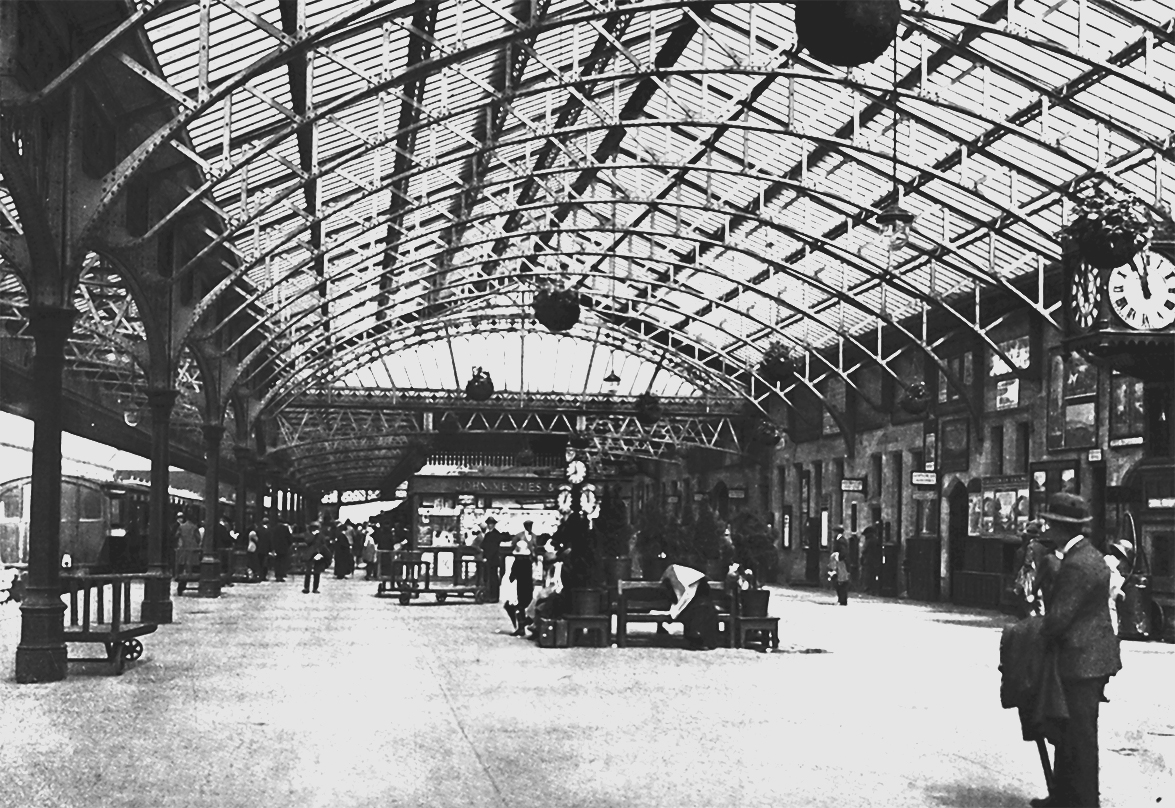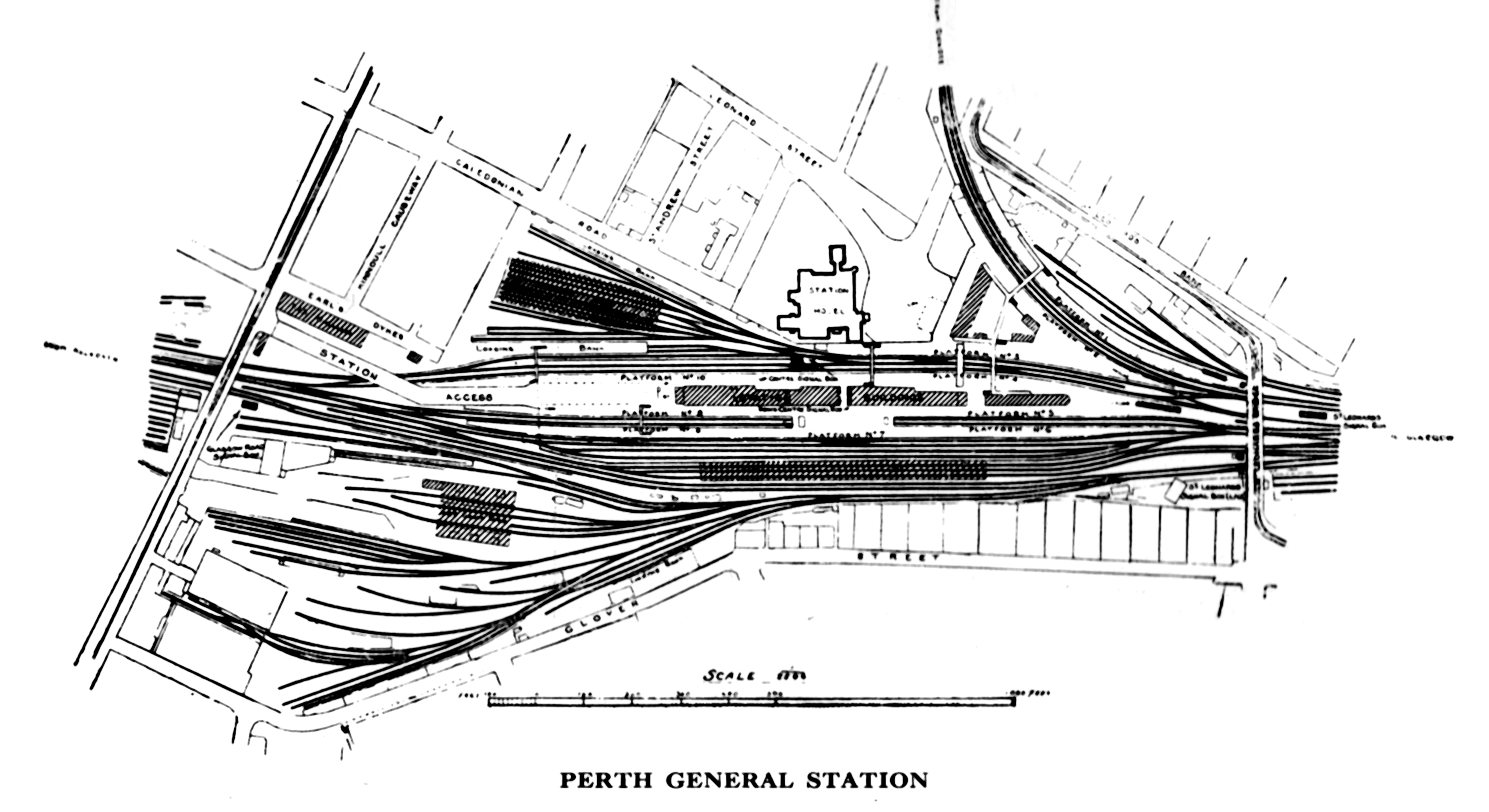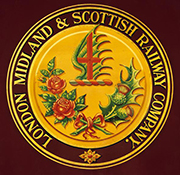

This site uses non-intrusive cookies to enable us to provide a better user experience for our visitors. No personal information is collected or stored from these cookies. The Society's policy is fully explained here. By continuing to use this site you are agreeing to the use of cookies.
[as described in the October 1928 edition of the “in-house” LMS Magazine.]

Perth General Station
THERE is probably no more interesting and important railway station in Scotland - except the main line termini - than Perth General Station. Centrally situated in historical and picturesque surroundings, it is the connecting link between south and north, east and west, with lines radiating in all four directions. Both the L M S and L. & N.E. companies have an interest in the station, which is managed by a joint committee of their representatives.
The L M S main lines from Carlisle, Glasgow and Edinburgh in the south to Inverness and the Highlands and Moray Firth coast, and to Aberdeen, in the north, pass through the station, while there are connections with Crieff and Oban and the West Highlands and Islands in the west and Dundee in the east. In addition, it is a terminus for the L. & N.E. lines from Glasgow and Edinburgh and their Fifeshire and Dundee lines.
The traffic passing through and arriving at Perth from all these sources is very considerable, and when it is borne in mind that the town is a favourite residential and tourist centre, and has important industries of its own, as well as being an important market town with all that implies in an agricultural connection, it will be realised that Perth General Station occupies a unique position in the railway world. It is, in fact, the greatest traffic point in the railway system of Central Scotland, and the interchange of vehicles and passengers which takes place there is on a very large scale.
The layout of the station is somewhat unusual. It consists of one large island platform with two bays let into each end. The station buildings, comprising most of the station offices, waiting and refreshment, &c., rooms, luggage, parcels, booking and other offices, are situated on this platform. These rooms are on the ground floor, and on the upper floor are offices for the accommodation of the district engineer and the district traffic officers and their staffs. Additional booking, &c., offices are provided at other points in the station for the convenience of passengers, and there are the usual book, tobacco and fruit stalls, while clock face finger post indicators direct passengers to the various trains. The principal access from the street is at the north end, where vehicular traffic enters from Glasgow Road via a bridge and slope; and there is a stairway at the south end connecting with St. Leonard's Road bridge.
The island platform extends in length to 1,415 ft. on the down side, and on the up side it reaches the phenomenal length of 1,672 ft. Crossovers are provided about midway on each side to enable immediately adjacent trains to reach or vacate the north or south portion of each platform by using the outside or middle line without interfering with trains occupying the corresponding south or north portion. On the down side there is a second outside line partly under cover. These outside lines and the middle lines beyond the main up platform are main ly used for re-marshalling purposes, changing engines, &c.
All told, there are 10 distinct platforms.
Nos. 1 and 2, known as the Dundee platforms, curve away from the south end of the main platform No.4 in such a way that their traffic can be operated, except for through traffic purposes, more or less independently of the main station. A middle line is provided between these platforms.
No. 3 platform-the hotel platform-is situated in the main station in the angle formed by the curving away of the Dundee lines. It is 679 ft. long, and at the north end leads to the horse and carriage loading docks and carriage cleaning shed. No.4, situated in the centre of the station, is the main south platform. Nos. 4 and 10 platforms are continuous. Nos. 5 and 6, to the east of No.4 and at the south end of the station, are principally used by the L. & N.E. south and east trains. They are 713 ft. and 550 ft. in length respectively. No.7, the main down platform, is divided into two portions-the north and the south-for traffic purposes, and No.8 at the north end, and alongside No.7, is generally used by trains for the Highland section. H is 655 ft. in length, and Platform No.9, which is alongside, is 665 ft. long, and is largely used for Crieff and Methven trains. All ten platforms are enclosed within the station roof, which has an area of 23,900 sq. yards.
Access between the main island platform and the hotel and Dundee platforms is obtained by a wide footbridge, and the Highland and Crieff dock lines are spanned by narrower footbridges which give connections with the Dundee platforms.
Perth General Station is an "open" station, and beyond Glasgow Road bridge. which crosses the station at the north end, there is it platform on the up line for the examination of tickets, and a corresponding platform at the south end, on the down line side, to the south of St. Leonard's Road bridge.
Four signal boxes are required for the working of the traffic in the station, and these are under the control of the station master, Mr. J. Rankine. St. Leonard's box, at the south end, is the largest, with 122 levers. Working at the north end is controlled by Glasgow Road box. which has 54 levers; while working within the station itself is controlled by the up and down centre boxes with 41 levers and 20 levers respectively. For various reasons it is difficult to advertise the platforms at which particular trains will be dealt with, and all the main line platforms are signalled both for up and down working.
The total mileage of running lines within the General Station is 2 miles 78 chains, in addition to which there are 4 miles 10 chains of sidings. 74 per cent. of this mileage is applicable to the L M S Company and the remainder to the L. & N.E. Company.
The original station was constructed following the passing of Bills in Parliament in the session 1844-45, authorising the making of the Scottish Central Railway, the Scottish Midland Junction Railway, the Dundee, Perth & Aberdeen Junction Railway, and the Edinburgh and Northern Lines. The Dundee, Perth and Aberdeen Junction Railway was opened in 1847, and the others referred to in the following year.
The first station contained only one through platform (the present No.7 platform) and two bay lines (the present Nos. 5 and 6 and Nos. 8 and 9 platforms); but in course of time this accommodation became inadequate as traffic increased, and it became necessary to make an extension, which was authorised in 1884 and completed in 1887. Before the enlargement was made there were no lines or platforms on the east side of the station buildings, which at that time contained the main station entrance, with their elevation facing Leonard Street. The Dundee side of the station was then formed, and at the same time the Station Hotel was built, the result being that the station buildings, which were formerly at the entrance to the station, now occupy a central position inside the station.
Included- in our plan are the Dundee lines curving eastwards. Before the extension of the station there was a small station used principally for the Dundee at right angles to the main lines, but when the alterations look place in 1887, this station was superseded by the present platforms Nos. 1 and 2. Neither the Dundee line nor the L. & N. E. goods yard, situated to the north-west of the main lines and shown at the left-hand bottom corner of the plan, is included in the lines under the jurisdiction of the General Station committee.
The town of Perth is of ancient foundation, but has suffered so much in the hands of marauders that little of historic interest remains except the tower of St. John's church. Its chief attraction lies in the natural beauty of its situation on the swiftly flowing Tay.
The Stone of Destiny, upon which Scottish Kings were crowned, and which is now the Coronation chair at Westminster, was brought by Edward 1 from the Place of Scone near Perth.

Site contents Copyright © LMS Society, 2025

December 8th, 2025
Site contents Copyright © LMS Society, 2025